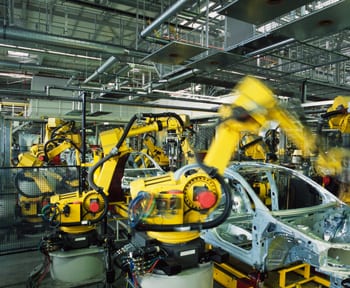The Economic Recovery is Fueling Ontario’s Auto Sector Growth

Home to five auto assemblers, 700 parts suppliers, and more than 500 tool, die, and mould makers, Ontario is regarded as a source of high-quality automotive manufacturing. Over the last five years, Ontario assembly plants produced nearly 16 per cent of North American-made vehicles; more than any other North American state or provincial jurisdiction. The automotive industry accounted for just over one-third of the province’s total exports. In 2014 alone, the Ontario auto industry produced $73 billion in vehicles and parts.
However, one does not have to stop for long to remember the 2008 downturn and the related stress and uncertainty surrounding the future of ‘The Big Three’ Detroit automakers – GM, Chrysler and Ford Motor Co. In total, the federal and Ontario provincial governments spent US$13.7 billion to bail out GM and Chrysler, since the companies had such strong ties to Canada. Now approaching the end of 2015, six years after the investment, what was the impact?
The State of Ontario’s Automotive Sector
According to a recent forecast from Export Development Canada (EDC), the value of Canadian motor vehicles and parts exports will have grown by 14% in 2015, with a further expansion of 5% in 2016. Indeed, forecasted growth is expected to support surging demand in the United States, as vehicle sales soar to pre-recession levels. Following years of market under-spending, vehicle replacement needs are high. Rapid employment growth, accessible financing, and lower gas prices will fuel the release of pent-up demand.
Related Blog: Keeping a Competitive Future for Ontario’s Automotive Industry – Ontario’s automotive industry is poised for long-term growth if electric vehicle (EV) production is increased. Discover how your automotive business can become more competitive through Canadian business grants.
Despite the projected growth, Ontario’s automotive cluster must ensure that it makes the necessary investments to remain competitive. Automotive OEMs, along with their Tier 1, 2 and 3 suppliers, are investing heavily in sustaining and enhancing Ontario automotive assembly plants through major investments such as:
- Honda of Canada: $857 million into their Alliston assembly plant;
- Toyota Motor Manufacturing Canada: $431 million into its Cambridge and Woodstock assembly plants;
- General Motors of Canada: $560 million to build Chevy Equinox at CAMI assembly plant in Ingersoll;
- Fiat Chrysler Automobiles: $2 billion into its Windsor assembly plant; and
- Ford of Canada: $700 million into its Oakville assembly plant.
The supply chain impacts of these OEM investments are significant. The province’s major automotive OEM operations are estimated to stimulate 311,000 additional jobs throughout the Ontario economy. It appears that the Ontario automotive cluster is positioned to benefit from new market forces, leveraging the previous government investments in 2009.
International Automotive Market Pressures
The risk is that other jurisdictional governments, such as Mexico and the southern U.S. states, are also incentivizing auto sector investments, such as Mexico and the southern U.S. states. To provide a high level summary, Mexico received $20 billion in new auto sector investments in the past four years while Canada received just $2.5 billion, according to the Center for Automotive Research in Ann Arbor, Michigan. In addition to lower wages, Mexico has free trade agreements with 45 other countries, making it easier to export product globally.
This trend to invest in Mexico and the southern United States will not disappear, however Ontario’s auto sector will be positioned to compete as long as strategic investments and critical analysis are undertaken to continuously leverage our skilled workforce and ability to manufacture high-quality, complex parts.
Related Blog: The Evolving Nature of the Canadian Automotive Sector – Understand how automotive industry trends are shaping Canada’s future in vehicle manufacturing and assembly. Access Canadian government funding programs to take advantage of market opportunities.
